McMaster BScN: Nursing Theory Paper - Roy's Adaptation Model
VerifiedAdded on 2022/08/19
|11
|2177
|17
Report
AI Summary
This paper applies Callista Roy's Adaptation Model to a nursing care scenario. It begins with an introduction to the model, outlining its key assumptions, concepts, and the four adaptive modes: physiological needs, self-concept, role function, and interdependence. The paper then presents a patient case, Mrs. Crane, admitted with yellow sputum and oxygen congestion. It identifies three priority client issues: inability to ingest food, decreasing oxygen levels, and a decreasing FEV1/FVC ratio. SMART goals are developed for each issue, focusing on specific, measurable, achievable, relevant, and time-bound objectives. The application of the model emphasizes adaptation to the environment, the nursing process and the health of the patient. The paper concludes by summarizing the value of Roy's Adaptation Model in enhancing nursing care and improving patient outcomes. The appendix includes a diagram of Roy's Adaptation Model.
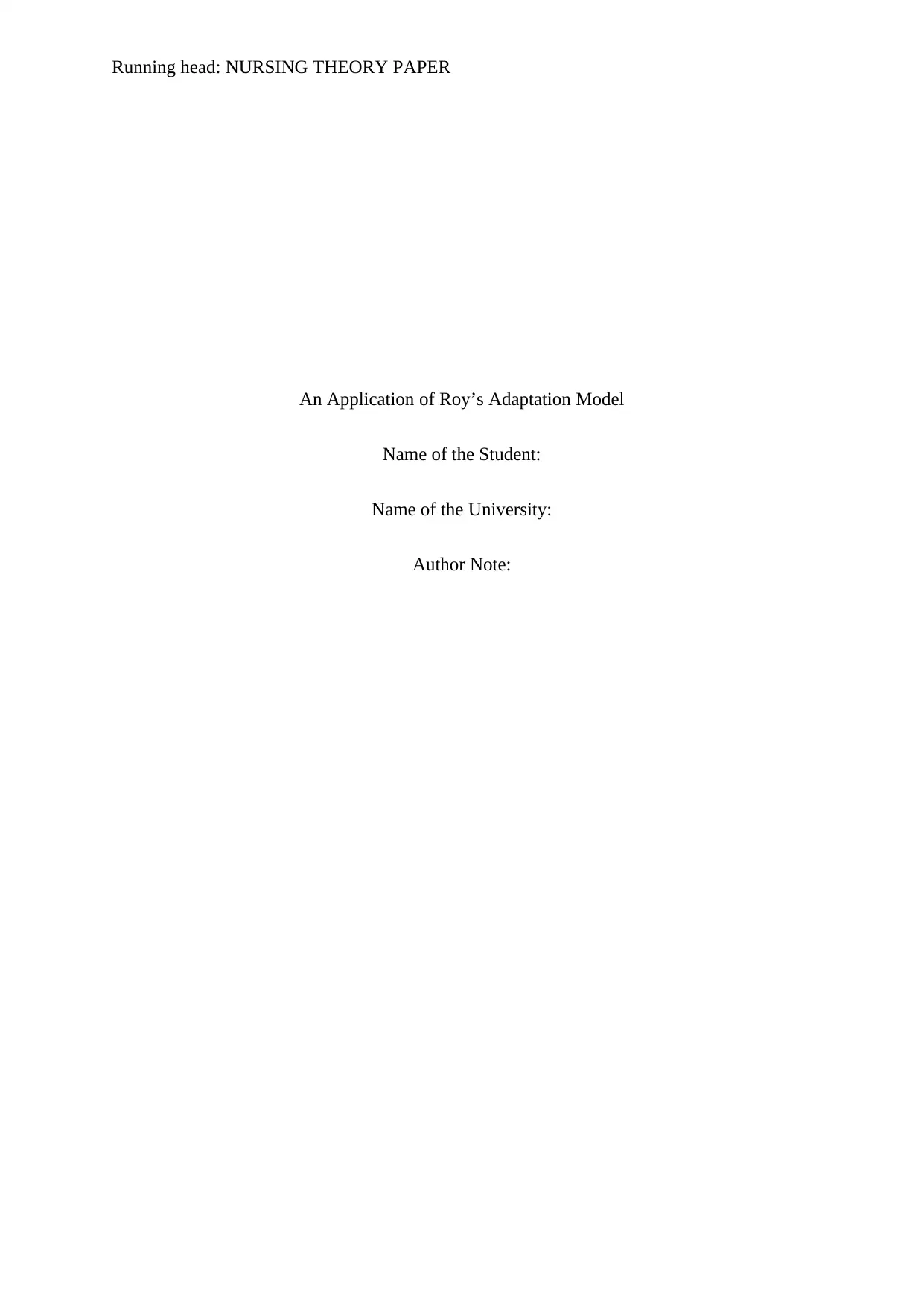
Running head: NURSING THEORY PAPER
An Application of Roy’s Adaptation Model
Name of the Student:
Name of the University:
Author Note:
An Application of Roy’s Adaptation Model
Name of the Student:
Name of the University:
Author Note:
Paraphrase This Document
Need a fresh take? Get an instant paraphrase of this document with our AI Paraphraser
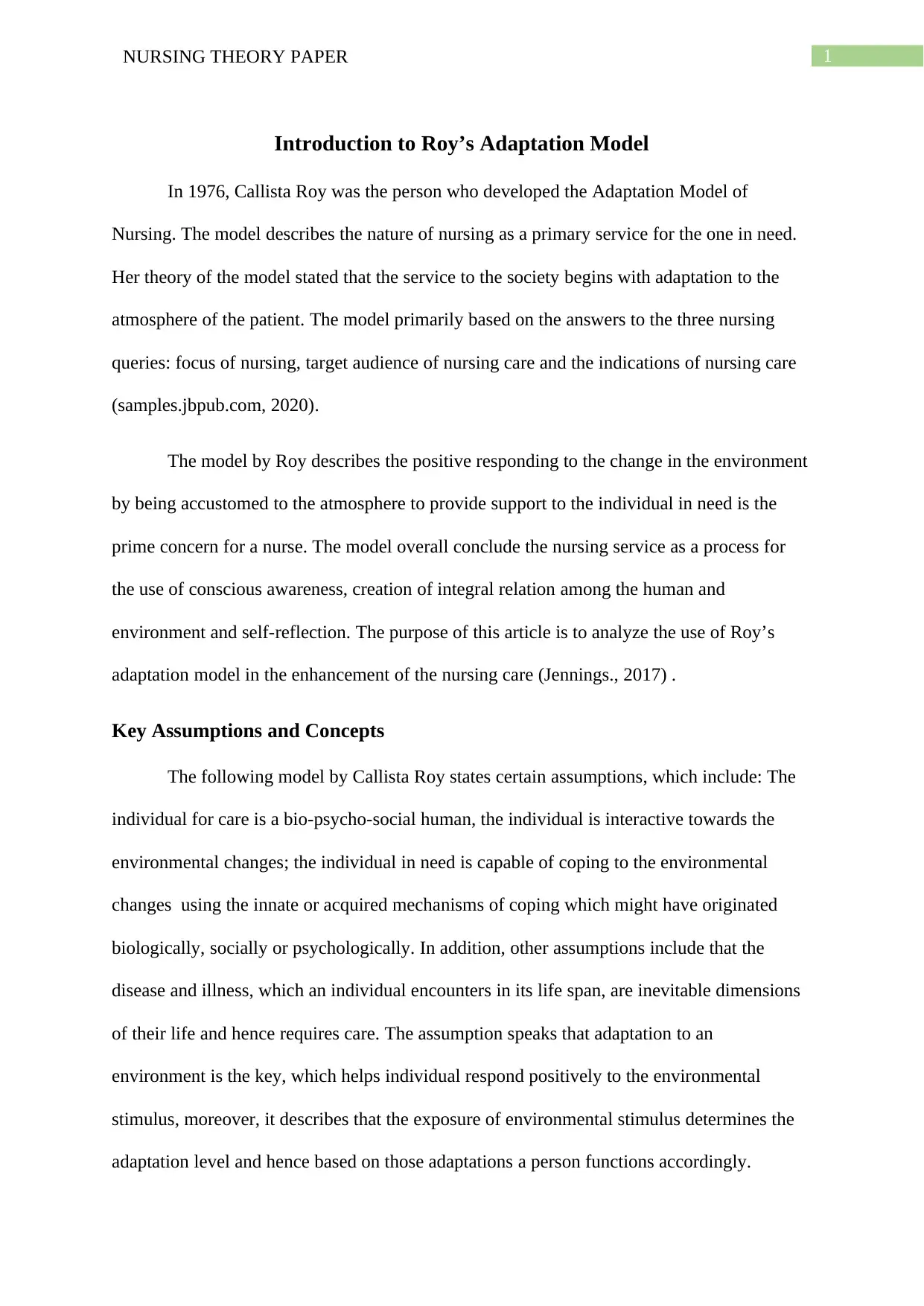
1NURSING THEORY PAPER
Introduction to Roy’s Adaptation Model
In 1976, Callista Roy was the person who developed the Adaptation Model of
Nursing. The model describes the nature of nursing as a primary service for the one in need.
Her theory of the model stated that the service to the society begins with adaptation to the
atmosphere of the patient. The model primarily based on the answers to the three nursing
queries: focus of nursing, target audience of nursing care and the indications of nursing care
(samples.jbpub.com, 2020).
The model by Roy describes the positive responding to the change in the environment
by being accustomed to the atmosphere to provide support to the individual in need is the
prime concern for a nurse. The model overall conclude the nursing service as a process for
the use of conscious awareness, creation of integral relation among the human and
environment and self-reflection. The purpose of this article is to analyze the use of Roy’s
adaptation model in the enhancement of the nursing care (Jennings., 2017) .
Key Assumptions and Concepts
The following model by Callista Roy states certain assumptions, which include: The
individual for care is a bio-psycho-social human, the individual is interactive towards the
environmental changes; the individual in need is capable of coping to the environmental
changes using the innate or acquired mechanisms of coping which might have originated
biologically, socially or psychologically. In addition, other assumptions include that the
disease and illness, which an individual encounters in its life span, are inevitable dimensions
of their life and hence requires care. The assumption speaks that adaptation to an
environment is the key, which helps individual respond positively to the environmental
stimulus, moreover, it describes that the exposure of environmental stimulus determines the
adaptation level and hence based on those adaptations a person functions accordingly.
Introduction to Roy’s Adaptation Model
In 1976, Callista Roy was the person who developed the Adaptation Model of
Nursing. The model describes the nature of nursing as a primary service for the one in need.
Her theory of the model stated that the service to the society begins with adaptation to the
atmosphere of the patient. The model primarily based on the answers to the three nursing
queries: focus of nursing, target audience of nursing care and the indications of nursing care
(samples.jbpub.com, 2020).
The model by Roy describes the positive responding to the change in the environment
by being accustomed to the atmosphere to provide support to the individual in need is the
prime concern for a nurse. The model overall conclude the nursing service as a process for
the use of conscious awareness, creation of integral relation among the human and
environment and self-reflection. The purpose of this article is to analyze the use of Roy’s
adaptation model in the enhancement of the nursing care (Jennings., 2017) .
Key Assumptions and Concepts
The following model by Callista Roy states certain assumptions, which include: The
individual for care is a bio-psycho-social human, the individual is interactive towards the
environmental changes; the individual in need is capable of coping to the environmental
changes using the innate or acquired mechanisms of coping which might have originated
biologically, socially or psychologically. In addition, other assumptions include that the
disease and illness, which an individual encounters in its life span, are inevitable dimensions
of their life and hence requires care. The assumption speaks that adaptation to an
environment is the key, which helps individual respond positively to the environmental
stimulus, moreover, it describes that the exposure of environmental stimulus determines the
adaptation level and hence based on those adaptations a person functions accordingly.
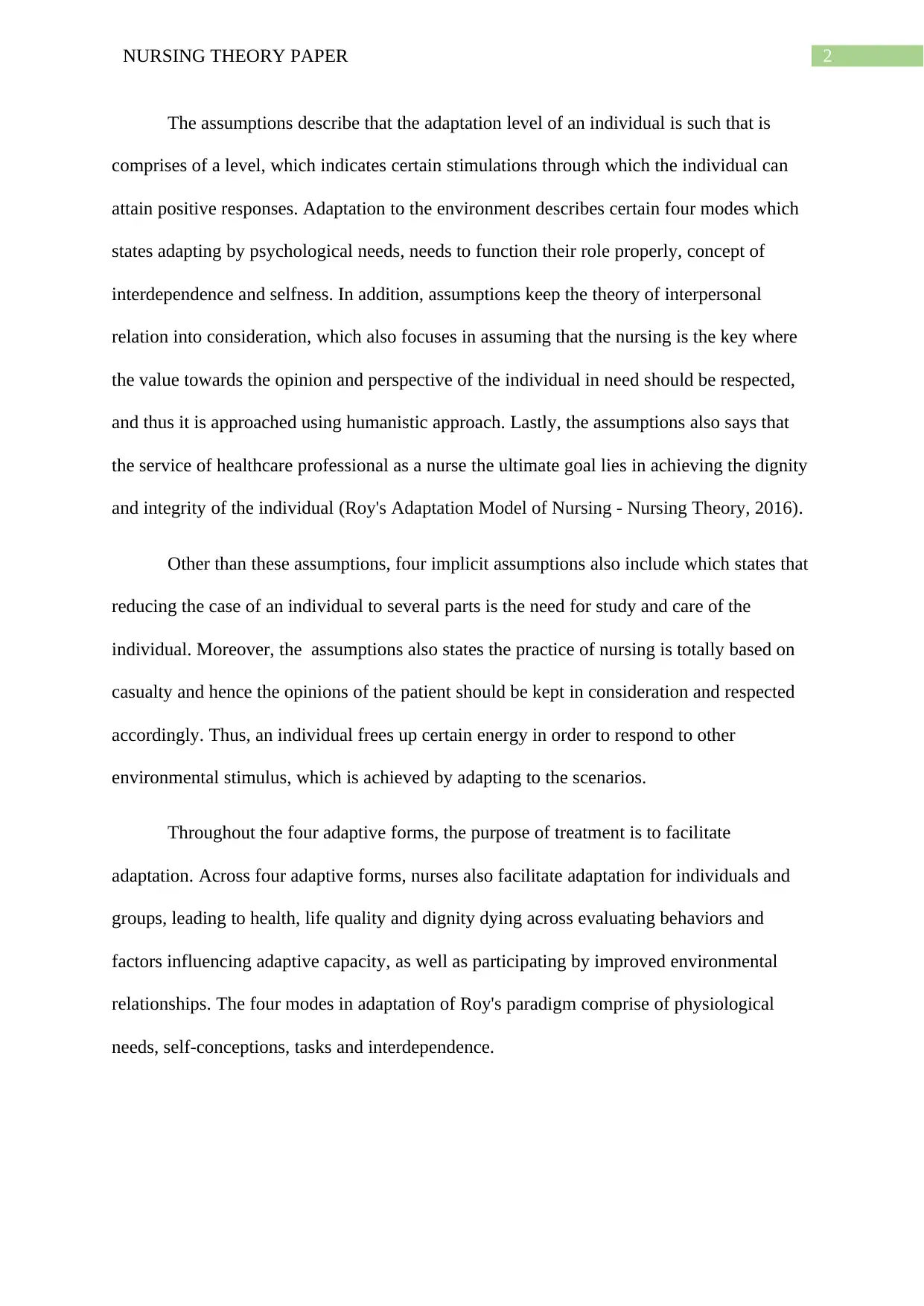
2NURSING THEORY PAPER
The assumptions describe that the adaptation level of an individual is such that is
comprises of a level, which indicates certain stimulations through which the individual can
attain positive responses. Adaptation to the environment describes certain four modes which
states adapting by psychological needs, needs to function their role properly, concept of
interdependence and selfness. In addition, assumptions keep the theory of interpersonal
relation into consideration, which also focuses in assuming that the nursing is the key where
the value towards the opinion and perspective of the individual in need should be respected,
and thus it is approached using humanistic approach. Lastly, the assumptions also says that
the service of healthcare professional as a nurse the ultimate goal lies in achieving the dignity
and integrity of the individual (Roy's Adaptation Model of Nursing - Nursing Theory, 2016).
Other than these assumptions, four implicit assumptions also include which states that
reducing the case of an individual to several parts is the need for study and care of the
individual. Moreover, the assumptions also states the practice of nursing is totally based on
casualty and hence the opinions of the patient should be kept in consideration and respected
accordingly. Thus, an individual frees up certain energy in order to respond to other
environmental stimulus, which is achieved by adapting to the scenarios.
Throughout the four adaptive forms, the purpose of treatment is to facilitate
adaptation. Across four adaptive forms, nurses also facilitate adaptation for individuals and
groups, leading to health, life quality and dignity dying across evaluating behaviors and
factors influencing adaptive capacity, as well as participating by improved environmental
relationships. The four modes in adaptation of Roy's paradigm comprise of physiological
needs, self-conceptions, tasks and interdependence.
The assumptions describe that the adaptation level of an individual is such that is
comprises of a level, which indicates certain stimulations through which the individual can
attain positive responses. Adaptation to the environment describes certain four modes which
states adapting by psychological needs, needs to function their role properly, concept of
interdependence and selfness. In addition, assumptions keep the theory of interpersonal
relation into consideration, which also focuses in assuming that the nursing is the key where
the value towards the opinion and perspective of the individual in need should be respected,
and thus it is approached using humanistic approach. Lastly, the assumptions also says that
the service of healthcare professional as a nurse the ultimate goal lies in achieving the dignity
and integrity of the individual (Roy's Adaptation Model of Nursing - Nursing Theory, 2016).
Other than these assumptions, four implicit assumptions also include which states that
reducing the case of an individual to several parts is the need for study and care of the
individual. Moreover, the assumptions also states the practice of nursing is totally based on
casualty and hence the opinions of the patient should be kept in consideration and respected
accordingly. Thus, an individual frees up certain energy in order to respond to other
environmental stimulus, which is achieved by adapting to the scenarios.
Throughout the four adaptive forms, the purpose of treatment is to facilitate
adaptation. Across four adaptive forms, nurses also facilitate adaptation for individuals and
groups, leading to health, life quality and dignity dying across evaluating behaviors and
factors influencing adaptive capacity, as well as participating by improved environmental
relationships. The four modes in adaptation of Roy's paradigm comprise of physiological
needs, self-conceptions, tasks and interdependence.
⊘ This is a preview!⊘
Do you want full access?
Subscribe today to unlock all pages.

Trusted by 1+ million students worldwide

3NURSING THEORY PAPER
Individual
According to the Roy’s model, an individual is a biological, psychological and social
being, who is in continuous interaction with the randomized environment. The adaptation
they acquire is achieved by the mechanisms of innate and acquired processes. Thus, this
model also includes the society as a whole system.
Health
The model states the factor of health as inevitable truth in the life of an individual,
and hence the health-illness continuum represents it. Getting integrated as a whole is the state
that the health as a function describes.
Environment
The model describes that the environment has three parts: focal, contextual and
residual. Focal make a person either internally or externally but immediately confront a
stimulus. Contextual states that the stimulus present in the surrounding will have affect over
the focal stimulus. In addition, the residual states that effects which needs to be cleared.
Thus, these conditions are the particular consideration of an individual’s mutuality
and the atmosphere or the environment.
Nursing
The subsystems include two forms as discussed in the mode. The cognate subsystem
is a prime process for coping involving four cognitive-emotive channels: perceptual and
information processing, learning, judgment, and emotion.
Six Step nursing process of the model
The adaptation model also describes certain steps or approach towards the nursing
process: Addressing patient behavior should be the first level of assessment, on the second
level of assessment the response towards the stimulus by the patient needs to be addressed,
Individual
According to the Roy’s model, an individual is a biological, psychological and social
being, who is in continuous interaction with the randomized environment. The adaptation
they acquire is achieved by the mechanisms of innate and acquired processes. Thus, this
model also includes the society as a whole system.
Health
The model states the factor of health as inevitable truth in the life of an individual,
and hence the health-illness continuum represents it. Getting integrated as a whole is the state
that the health as a function describes.
Environment
The model describes that the environment has three parts: focal, contextual and
residual. Focal make a person either internally or externally but immediately confront a
stimulus. Contextual states that the stimulus present in the surrounding will have affect over
the focal stimulus. In addition, the residual states that effects which needs to be cleared.
Thus, these conditions are the particular consideration of an individual’s mutuality
and the atmosphere or the environment.
Nursing
The subsystems include two forms as discussed in the mode. The cognate subsystem
is a prime process for coping involving four cognitive-emotive channels: perceptual and
information processing, learning, judgment, and emotion.
Six Step nursing process of the model
The adaptation model also describes certain steps or approach towards the nursing
process: Addressing patient behavior should be the first level of assessment, on the second
level of assessment the response towards the stimulus by the patient needs to be addressed,
Paraphrase This Document
Need a fresh take? Get an instant paraphrase of this document with our AI Paraphraser
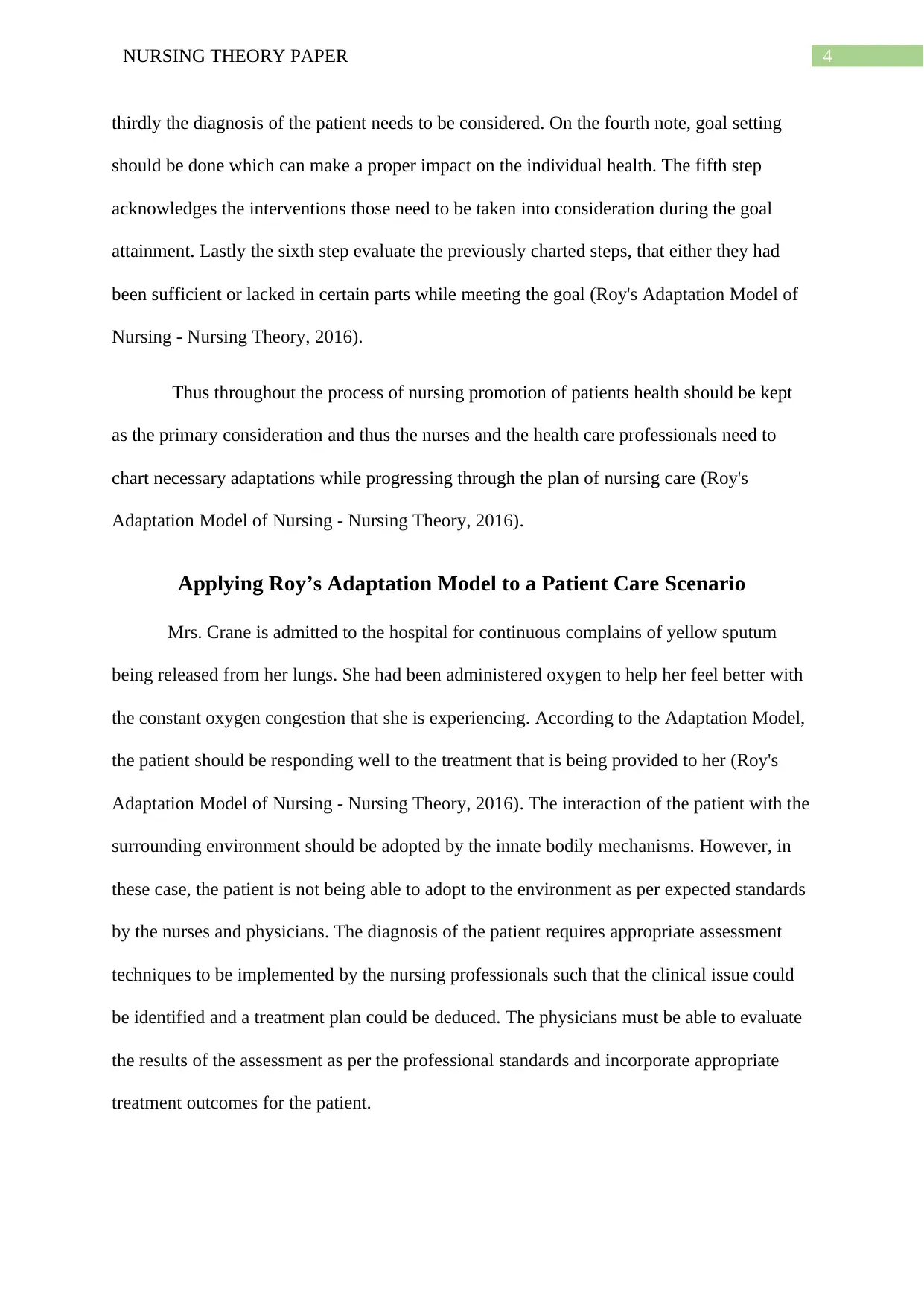
4NURSING THEORY PAPER
thirdly the diagnosis of the patient needs to be considered. On the fourth note, goal setting
should be done which can make a proper impact on the individual health. The fifth step
acknowledges the interventions those need to be taken into consideration during the goal
attainment. Lastly the sixth step evaluate the previously charted steps, that either they had
been sufficient or lacked in certain parts while meeting the goal (Roy's Adaptation Model of
Nursing - Nursing Theory, 2016).
Thus throughout the process of nursing promotion of patients health should be kept
as the primary consideration and thus the nurses and the health care professionals need to
chart necessary adaptations while progressing through the plan of nursing care (Roy's
Adaptation Model of Nursing - Nursing Theory, 2016).
Applying Roy’s Adaptation Model to a Patient Care Scenario
Mrs. Crane is admitted to the hospital for continuous complains of yellow sputum
being released from her lungs. She had been administered oxygen to help her feel better with
the constant oxygen congestion that she is experiencing. According to the Adaptation Model,
the patient should be responding well to the treatment that is being provided to her (Roy's
Adaptation Model of Nursing - Nursing Theory, 2016). The interaction of the patient with the
surrounding environment should be adopted by the innate bodily mechanisms. However, in
these case, the patient is not being able to adopt to the environment as per expected standards
by the nurses and physicians. The diagnosis of the patient requires appropriate assessment
techniques to be implemented by the nursing professionals such that the clinical issue could
be identified and a treatment plan could be deduced. The physicians must be able to evaluate
the results of the assessment as per the professional standards and incorporate appropriate
treatment outcomes for the patient.
thirdly the diagnosis of the patient needs to be considered. On the fourth note, goal setting
should be done which can make a proper impact on the individual health. The fifth step
acknowledges the interventions those need to be taken into consideration during the goal
attainment. Lastly the sixth step evaluate the previously charted steps, that either they had
been sufficient or lacked in certain parts while meeting the goal (Roy's Adaptation Model of
Nursing - Nursing Theory, 2016).
Thus throughout the process of nursing promotion of patients health should be kept
as the primary consideration and thus the nurses and the health care professionals need to
chart necessary adaptations while progressing through the plan of nursing care (Roy's
Adaptation Model of Nursing - Nursing Theory, 2016).
Applying Roy’s Adaptation Model to a Patient Care Scenario
Mrs. Crane is admitted to the hospital for continuous complains of yellow sputum
being released from her lungs. She had been administered oxygen to help her feel better with
the constant oxygen congestion that she is experiencing. According to the Adaptation Model,
the patient should be responding well to the treatment that is being provided to her (Roy's
Adaptation Model of Nursing - Nursing Theory, 2016). The interaction of the patient with the
surrounding environment should be adopted by the innate bodily mechanisms. However, in
these case, the patient is not being able to adopt to the environment as per expected standards
by the nurses and physicians. The diagnosis of the patient requires appropriate assessment
techniques to be implemented by the nursing professionals such that the clinical issue could
be identified and a treatment plan could be deduced. The physicians must be able to evaluate
the results of the assessment as per the professional standards and incorporate appropriate
treatment outcomes for the patient.
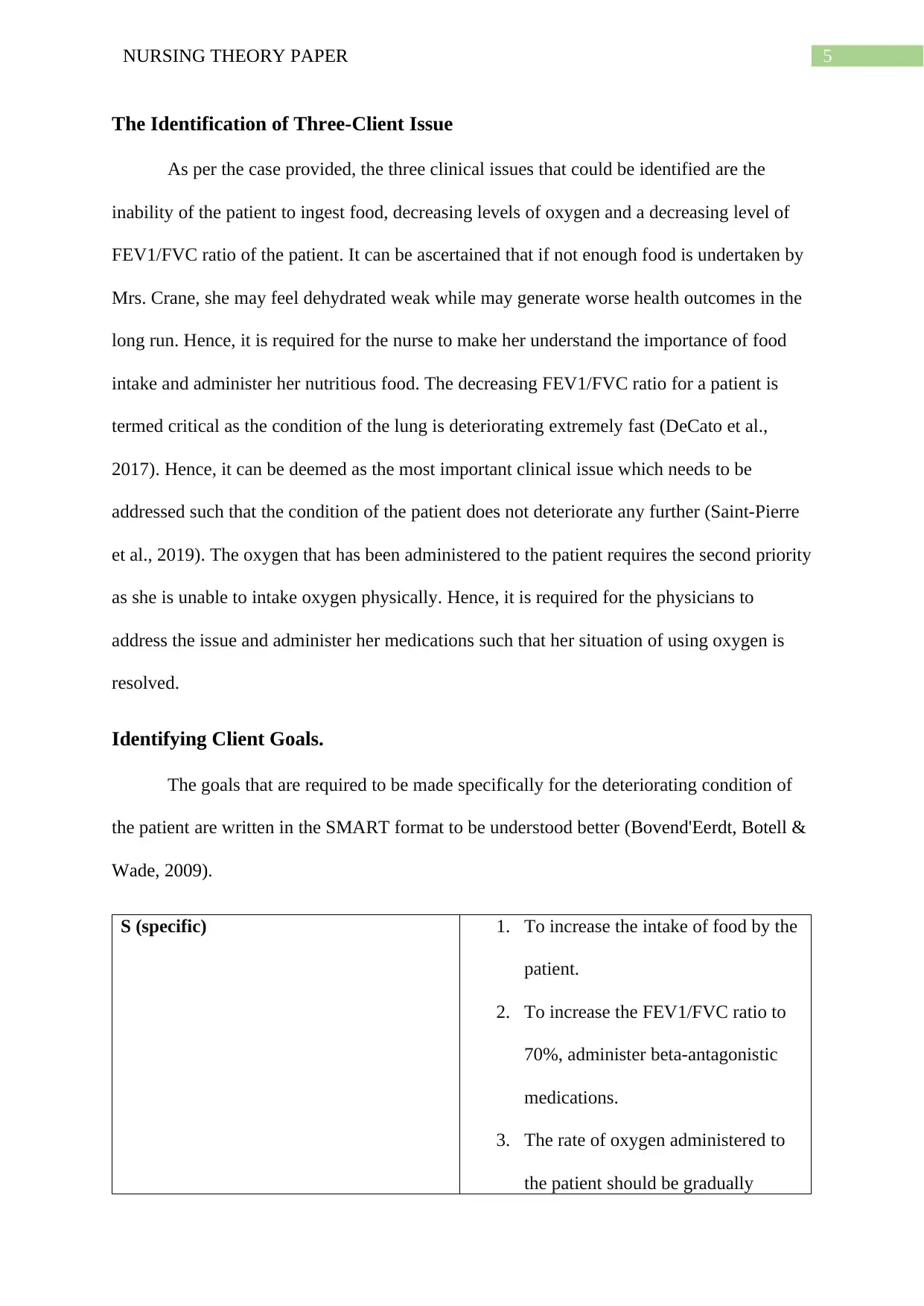
5NURSING THEORY PAPER
The Identification of Three-Client Issue
As per the case provided, the three clinical issues that could be identified are the
inability of the patient to ingest food, decreasing levels of oxygen and a decreasing level of
FEV1/FVC ratio of the patient. It can be ascertained that if not enough food is undertaken by
Mrs. Crane, she may feel dehydrated weak while may generate worse health outcomes in the
long run. Hence, it is required for the nurse to make her understand the importance of food
intake and administer her nutritious food. The decreasing FEV1/FVC ratio for a patient is
termed critical as the condition of the lung is deteriorating extremely fast (DeCato et al.,
2017). Hence, it can be deemed as the most important clinical issue which needs to be
addressed such that the condition of the patient does not deteriorate any further (Saint-Pierre
et al., 2019). The oxygen that has been administered to the patient requires the second priority
as she is unable to intake oxygen physically. Hence, it is required for the physicians to
address the issue and administer her medications such that her situation of using oxygen is
resolved.
Identifying Client Goals.
The goals that are required to be made specifically for the deteriorating condition of
the patient are written in the SMART format to be understood better (Bovend'Eerdt, Botell &
Wade, 2009).
S (specific) 1. To increase the intake of food by the
patient.
2. To increase the FEV1/FVC ratio to
70%, administer beta-antagonistic
medications.
3. The rate of oxygen administered to
the patient should be gradually
The Identification of Three-Client Issue
As per the case provided, the three clinical issues that could be identified are the
inability of the patient to ingest food, decreasing levels of oxygen and a decreasing level of
FEV1/FVC ratio of the patient. It can be ascertained that if not enough food is undertaken by
Mrs. Crane, she may feel dehydrated weak while may generate worse health outcomes in the
long run. Hence, it is required for the nurse to make her understand the importance of food
intake and administer her nutritious food. The decreasing FEV1/FVC ratio for a patient is
termed critical as the condition of the lung is deteriorating extremely fast (DeCato et al.,
2017). Hence, it can be deemed as the most important clinical issue which needs to be
addressed such that the condition of the patient does not deteriorate any further (Saint-Pierre
et al., 2019). The oxygen that has been administered to the patient requires the second priority
as she is unable to intake oxygen physically. Hence, it is required for the physicians to
address the issue and administer her medications such that her situation of using oxygen is
resolved.
Identifying Client Goals.
The goals that are required to be made specifically for the deteriorating condition of
the patient are written in the SMART format to be understood better (Bovend'Eerdt, Botell &
Wade, 2009).
S (specific) 1. To increase the intake of food by the
patient.
2. To increase the FEV1/FVC ratio to
70%, administer beta-antagonistic
medications.
3. The rate of oxygen administered to
the patient should be gradually
⊘ This is a preview!⊘
Do you want full access?
Subscribe today to unlock all pages.

Trusted by 1+ million students worldwide

6NURSING THEORY PAPER
increased till 40% for at least 3
minutes intervals.
M (measurable) 1. The generation of stronger health in
the patient is the evidence that the
goal has been implemented and
shown effect.
2. After the administration of relevant
medications to the patient, an
increase in the ratio is observed as
measured by the physician.
3. The ability of the patient to use up
the oxygen is observed after her vital
stats has been improving.
A (achievable) The above mentioned clinical issues could
be achieved by the proper administration of
medication to the patient and adopting to
newer nursing techniques of oxygen
administration. In addition, the food to be
administered are achievable by the
improvement observed in the physical well-
being of the patient.
R (relevant) The health of the patient should be improved
by the administration of food. This, in turn,
can help in improving the vital signs of the
patient and increasing the FEV1/FVC ratio.
increased till 40% for at least 3
minutes intervals.
M (measurable) 1. The generation of stronger health in
the patient is the evidence that the
goal has been implemented and
shown effect.
2. After the administration of relevant
medications to the patient, an
increase in the ratio is observed as
measured by the physician.
3. The ability of the patient to use up
the oxygen is observed after her vital
stats has been improving.
A (achievable) The above mentioned clinical issues could
be achieved by the proper administration of
medication to the patient and adopting to
newer nursing techniques of oxygen
administration. In addition, the food to be
administered are achievable by the
improvement observed in the physical well-
being of the patient.
R (relevant) The health of the patient should be improved
by the administration of food. This, in turn,
can help in improving the vital signs of the
patient and increasing the FEV1/FVC ratio.
Paraphrase This Document
Need a fresh take? Get an instant paraphrase of this document with our AI Paraphraser
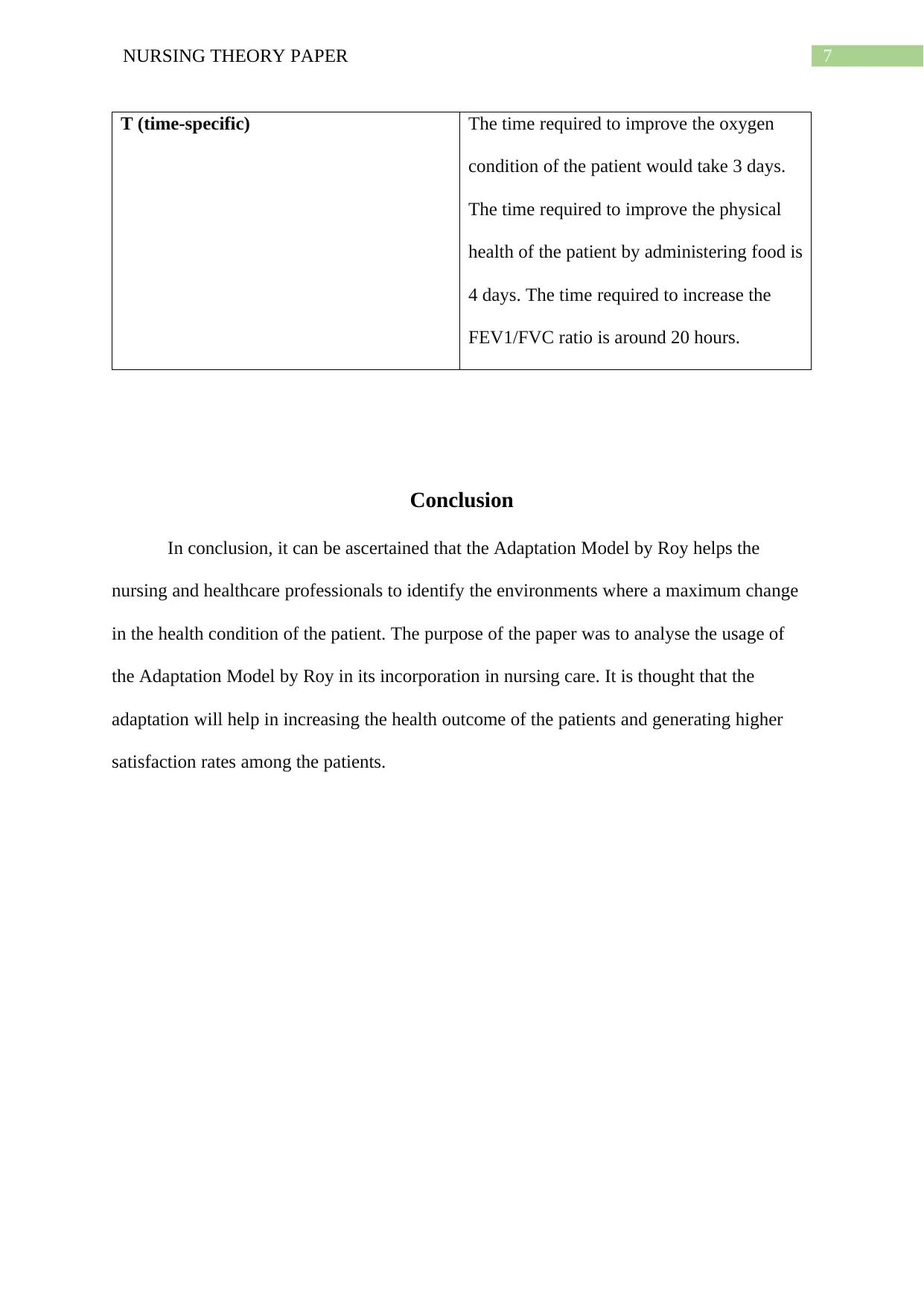
7NURSING THEORY PAPER
T (time-specific) The time required to improve the oxygen
condition of the patient would take 3 days.
The time required to improve the physical
health of the patient by administering food is
4 days. The time required to increase the
FEV1/FVC ratio is around 20 hours.
Conclusion
In conclusion, it can be ascertained that the Adaptation Model by Roy helps the
nursing and healthcare professionals to identify the environments where a maximum change
in the health condition of the patient. The purpose of the paper was to analyse the usage of
the Adaptation Model by Roy in its incorporation in nursing care. It is thought that the
adaptation will help in increasing the health outcome of the patients and generating higher
satisfaction rates among the patients.
T (time-specific) The time required to improve the oxygen
condition of the patient would take 3 days.
The time required to improve the physical
health of the patient by administering food is
4 days. The time required to increase the
FEV1/FVC ratio is around 20 hours.
Conclusion
In conclusion, it can be ascertained that the Adaptation Model by Roy helps the
nursing and healthcare professionals to identify the environments where a maximum change
in the health condition of the patient. The purpose of the paper was to analyse the usage of
the Adaptation Model by Roy in its incorporation in nursing care. It is thought that the
adaptation will help in increasing the health outcome of the patients and generating higher
satisfaction rates among the patients.
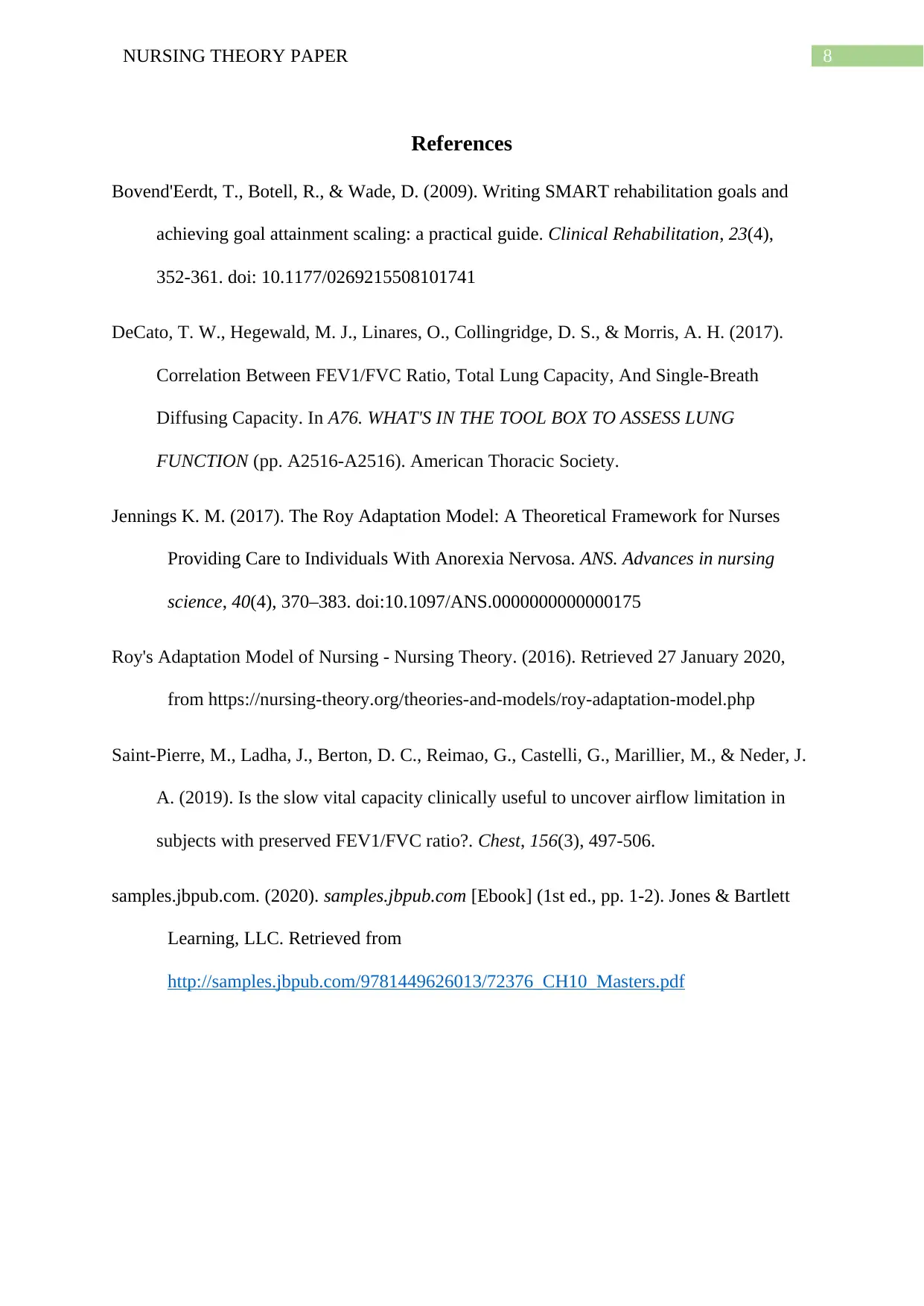
8NURSING THEORY PAPER
References
Bovend'Eerdt, T., Botell, R., & Wade, D. (2009). Writing SMART rehabilitation goals and
achieving goal attainment scaling: a practical guide. Clinical Rehabilitation, 23(4),
352-361. doi: 10.1177/0269215508101741
DeCato, T. W., Hegewald, M. J., Linares, O., Collingridge, D. S., & Morris, A. H. (2017).
Correlation Between FEV1/FVC Ratio, Total Lung Capacity, And Single-Breath
Diffusing Capacity. In A76. WHAT'S IN THE TOOL BOX TO ASSESS LUNG
FUNCTION (pp. A2516-A2516). American Thoracic Society.
Jennings K. M. (2017). The Roy Adaptation Model: A Theoretical Framework for Nurses
Providing Care to Individuals With Anorexia Nervosa. ANS. Advances in nursing
science, 40(4), 370–383. doi:10.1097/ANS.0000000000000175
Roy's Adaptation Model of Nursing - Nursing Theory. (2016). Retrieved 27 January 2020,
from https://nursing-theory.org/theories-and-models/roy-adaptation-model.php
Saint-Pierre, M., Ladha, J., Berton, D. C., Reimao, G., Castelli, G., Marillier, M., & Neder, J.
A. (2019). Is the slow vital capacity clinically useful to uncover airflow limitation in
subjects with preserved FEV1/FVC ratio?. Chest, 156(3), 497-506.
samples.jbpub.com. (2020). samples.jbpub.com [Ebook] (1st ed., pp. 1-2). Jones & Bartlett
Learning, LLC. Retrieved from
http://samples.jbpub.com/9781449626013/72376_CH10_Masters.pdf
References
Bovend'Eerdt, T., Botell, R., & Wade, D. (2009). Writing SMART rehabilitation goals and
achieving goal attainment scaling: a practical guide. Clinical Rehabilitation, 23(4),
352-361. doi: 10.1177/0269215508101741
DeCato, T. W., Hegewald, M. J., Linares, O., Collingridge, D. S., & Morris, A. H. (2017).
Correlation Between FEV1/FVC Ratio, Total Lung Capacity, And Single-Breath
Diffusing Capacity. In A76. WHAT'S IN THE TOOL BOX TO ASSESS LUNG
FUNCTION (pp. A2516-A2516). American Thoracic Society.
Jennings K. M. (2017). The Roy Adaptation Model: A Theoretical Framework for Nurses
Providing Care to Individuals With Anorexia Nervosa. ANS. Advances in nursing
science, 40(4), 370–383. doi:10.1097/ANS.0000000000000175
Roy's Adaptation Model of Nursing - Nursing Theory. (2016). Retrieved 27 January 2020,
from https://nursing-theory.org/theories-and-models/roy-adaptation-model.php
Saint-Pierre, M., Ladha, J., Berton, D. C., Reimao, G., Castelli, G., Marillier, M., & Neder, J.
A. (2019). Is the slow vital capacity clinically useful to uncover airflow limitation in
subjects with preserved FEV1/FVC ratio?. Chest, 156(3), 497-506.
samples.jbpub.com. (2020). samples.jbpub.com [Ebook] (1st ed., pp. 1-2). Jones & Bartlett
Learning, LLC. Retrieved from
http://samples.jbpub.com/9781449626013/72376_CH10_Masters.pdf
⊘ This is a preview!⊘
Do you want full access?
Subscribe today to unlock all pages.

Trusted by 1+ million students worldwide
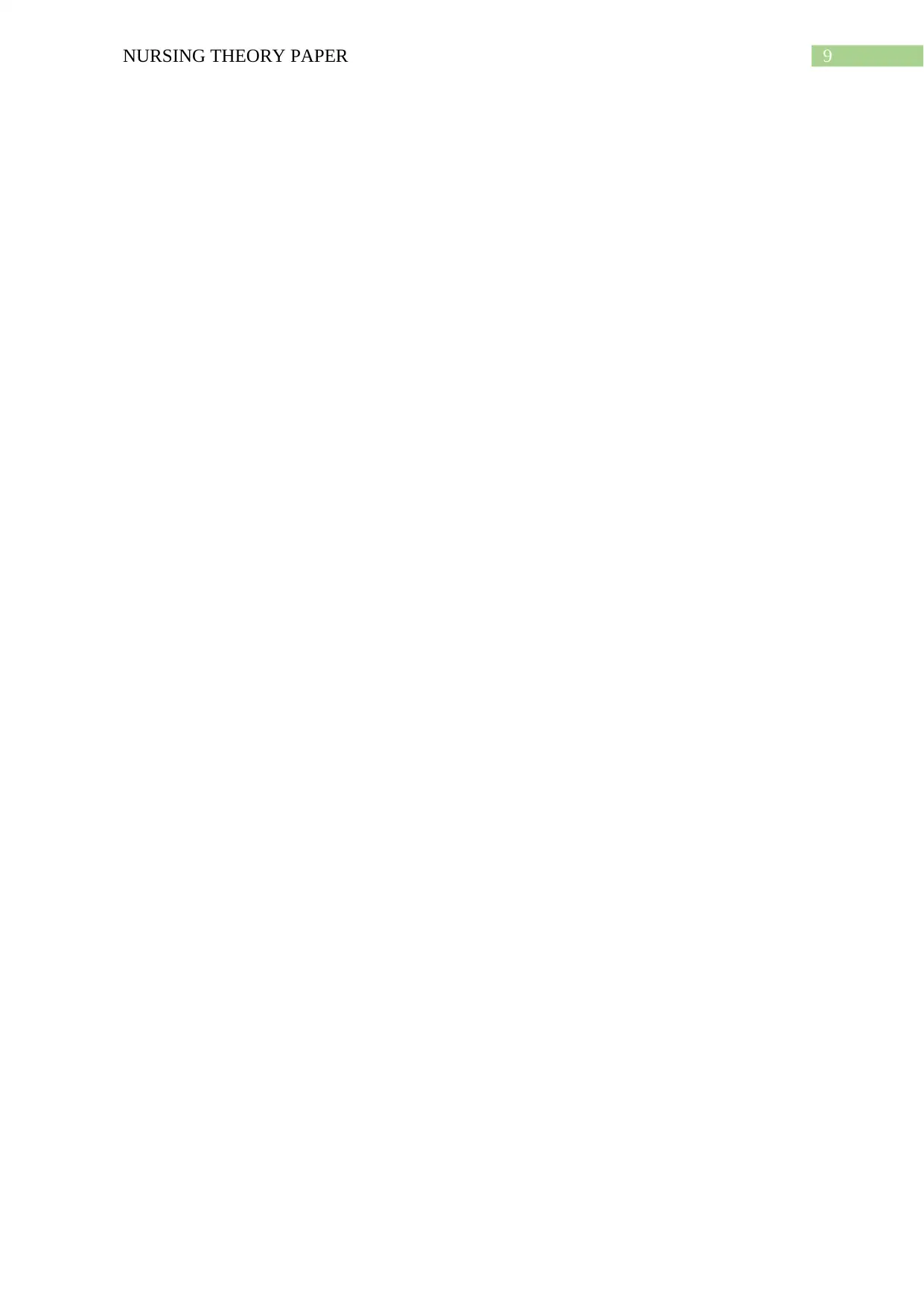
9NURSING THEORY PAPER
Paraphrase This Document
Need a fresh take? Get an instant paraphrase of this document with our AI Paraphraser

10NURSING THEORY PAPER
Appendix A
Roy’s Adaptation Model
Adapted from: Roy, C. (1976). Roy’s Adaptation Model. Retrieved from
https://nurseslabs.com/sister-callista-roys-adaptation-model/
Appendix A
Roy’s Adaptation Model
Adapted from: Roy, C. (1976). Roy’s Adaptation Model. Retrieved from
https://nurseslabs.com/sister-callista-roys-adaptation-model/
1 out of 11
Related Documents
Your All-in-One AI-Powered Toolkit for Academic Success.
+13062052269
info@desklib.com
Available 24*7 on WhatsApp / Email
![[object Object]](/_next/static/media/star-bottom.7253800d.svg)
Unlock your academic potential
Copyright © 2020–2025 A2Z Services. All Rights Reserved. Developed and managed by ZUCOL.




